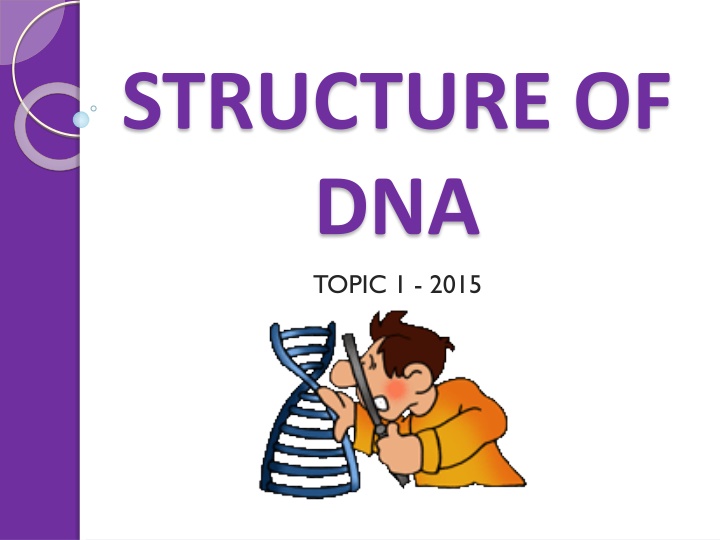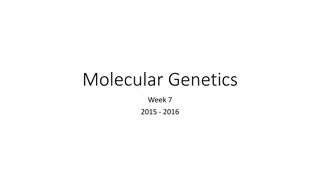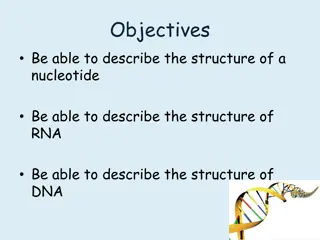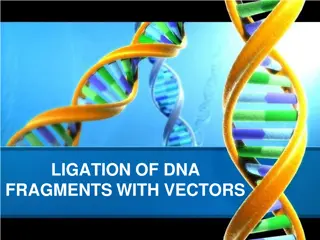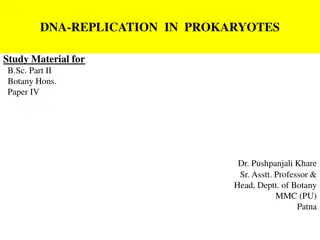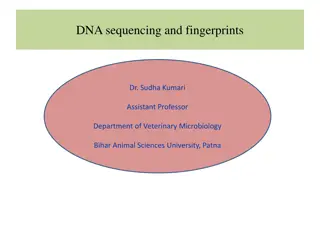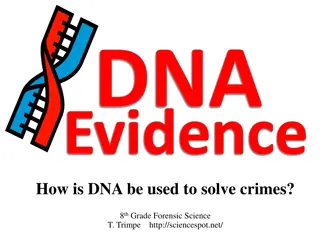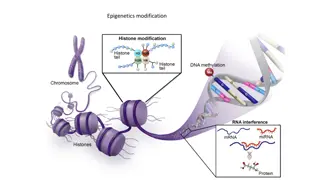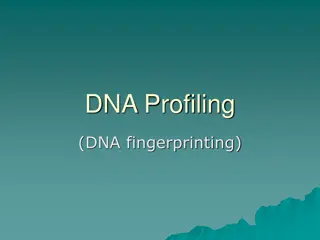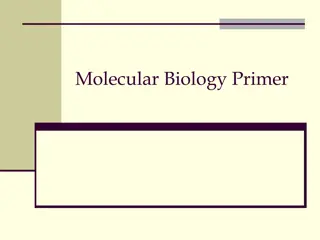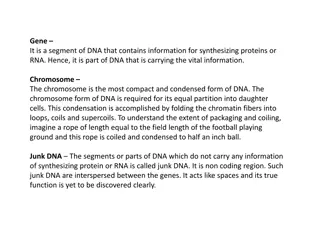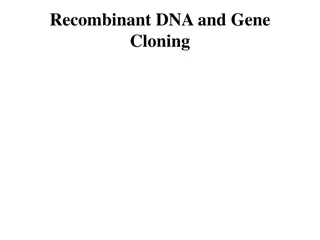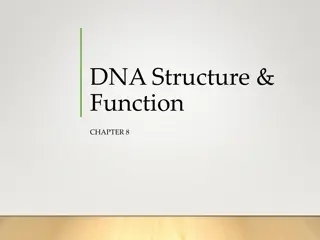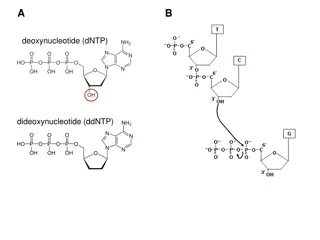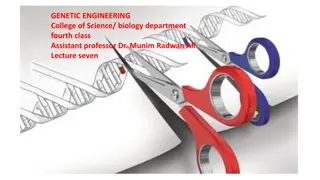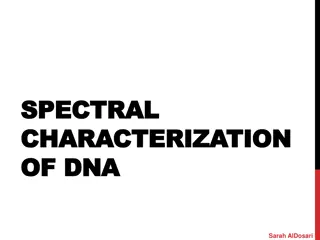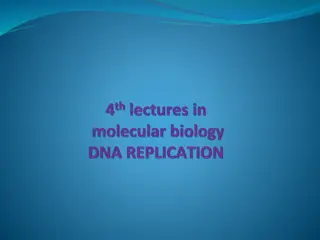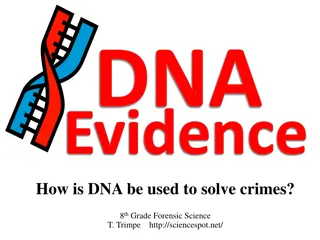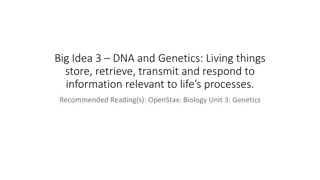Evolution of DNA Discovery and Understanding Through History
Delve into the captivating history of DNA, from its discovery by Friedrich Miescher in 1869 to the groundbreaking research of Rosalind Franklin in 1953. Follow the journey of scientific pioneers as they unraveled the mysteries of DNA's structure, composition, and role in genetic information transfer. Witness key milestones such as the identification of nucleotides by Phoebus Levene in 1929 and the elucidation of Chargaff's rule in 1950. Explore how these discoveries laid the foundation for our modern understanding of DNA and genetics.
Download Presentation

Please find below an Image/Link to download the presentation.
The content on the website is provided AS IS for your information and personal use only. It may not be sold, licensed, or shared on other websites without obtaining consent from the author.If you encounter any issues during the download, it is possible that the publisher has removed the file from their server.
You are allowed to download the files provided on this website for personal or commercial use, subject to the condition that they are used lawfully. All files are the property of their respective owners.
The content on the website is provided AS IS for your information and personal use only. It may not be sold, licensed, or shared on other websites without obtaining consent from the author.
E N D
Presentation Transcript
STRUCTURE OF DNA TOPIC 1 - 2015
YEAR 10 BIOLOGY Topics Structure of DNA Chromosomes & Cell division Genetics & Inheritance Theory of Evolution Evidence for Evolution
YEAR 10 BIOLOGY Assessment Evolution poster Genetics prac report Unit test End of semester examination and various worksheets / quizzes throughout the course...
STRUCTURE OF DNA Things to cover History Location Components Base pairing Shape
HISTORY OF DNA 1869 DNA was discovered by Friedrich Miescher His team isolated it from pus on bandages! He called their discovery nuclein.
HISTORY OF DNA 1929 Phoebus Levene determined that the compound had a repeating structure. He called these repeated units nucleotides. He also suggested that these units link together to form chains. His theory was correct, but his prediction about the way the chains formed was not.
HISTORY OF DNA 1943-1953 Oswald Avery , and Alfred Hershey and Martha Chase made the suggestion that this compound was capable of transferring genetic information between generations
HISTORY OF DNA 1950 Erwin Chargaff determined that there were four types of nucleotides that paired up within the structure of DNA This is known as Chargaff s rule or the base pairing rule.
HISTORY OF DNA 1953 Rosalind Franklin came very close to solving the DNA structure She made xray crystallographic portraits of DNA in order to try to determine its 3D structure. Source: www.makingthemodernworld.org.uk
HISTORY OF DNA 1953 Her work was given without her consent to a group of scientists in another laboratory by her colleague, Maurice Wilkins. Source: www.makingthemodernworld.org.uk
HISTORY OF DNA 1953 James Watson and Francis Crick made a model of DNA that incorporated the findings of Chargaff, Franklin and Wilkins. Their model fit the experiential data so perfectly that it was almost immediately accepted. Source: tokresource.org
HISTORY OF DNA 1962 JOHN STEINBECK WATSON WILKINS Watson, Crick, and Wilkins won the Nobel Prize for physiology/ medicine. CRICK Rosalind Franklin had died of cancer in 1956. Source: achievement.org
HISTORY OF DNA 1962 The Nobel Prize only goes to living recipients, and can only be shared among three winners. Were she alive, do you think she would have been included in the prize? Source: omniscienceblog.com
LOCATION OF DNA DNA is a chemical located in the nucleus of every living cell.
LOCATION OF DNA It is a nucleic acid. Its full name is deoxyribonucleic acid. Its role is to store coded instructions about how to make proteins. In this way, it directs cell division, growth & function.
COMPONENTS OF DNA
COMPONENTS OF DNA DNA is a large molecule made up of smaller sub-units called nucleotides Each nucleotide consists of: a nitrogenous base a pentose sugar a phosphate group There are four different DNA nucleotides
COMPONENTS OF DNA Pentose sugars There are two sugars that are used in nucleotides: deoxyribose sugar used inDNA ribose sugar used in RNA
COMPONENTS OF DNA Nitrogen bases There are four nitrogen bases in DNA: A= Adenine T= Thymine G= Guanine C= Cytosine There is a fifth nitrogen base found only in RNA: U= Uracil
COMPONENTS OF DNA Chemical bonds The three components are held together by covalent bonds. These bonds are strong so that the unit holds together within the larger molecule.
CHARGAFFS BASE PAIRING RULE
BASE PAIRING IN DNA The nitrogen bases exhibit complementary base pairing. This means that each base only join with one other base: Adenine joins with Thymine (A=T) Guanine joins with Cytosine (C G) A T C G
BASE PAIRING IN DNA Reasons behind the rule: Size of bases Number of hydrogen bonding sites
SHAPE OF DNA DNA is double stranded. Each strand is made up of nucleotides, connected through chemical bonds. These two strands are twisted around each other. This is called a double helix.
SHAPE OF DNA The structure is similar to a twisted ladder. The rungs of the ladder are made from the complementary nitrogen base pairs. The sides of the ladder are made from alternatingsugarand phosphategroups. This is called the sugar-phosphate backbone.
COMPLEMENTARY NITROGEN BASE PAIRS A T SUGAR-PHOSPHATE BACKBONE SUGAR-PHOSPHATE BACKBONE C G C G T A G C
SHAPE OF DNA The nucleotides are joined by covalent bonds these are very strong The two strands are joined by hydrogen bonds these are very weak, This allows the strands to be separated during DNA replication and protein synthesis without destroying the DNA completely
A T C G C G T A G C
